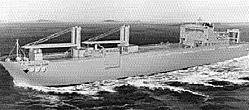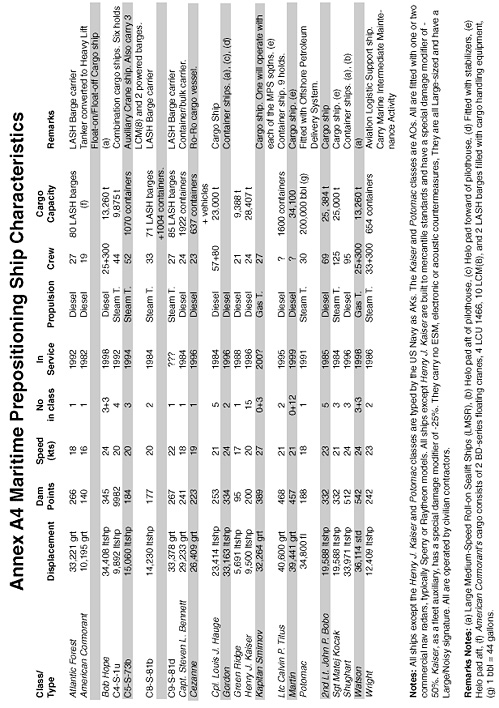 USNS Bob Hope (TAKR-300) (Avondale Industries)
USNS Bob Hope (TAKR-300) (Avondale Industries)
The United States has a fleet of over thirty ships. They operate world-wide, are vital to our foreign presence and our global reach, and almost nobody hears about them. Why? There's not a gun on the lot. The most powerful sensor on any of them is a nav radar, and yet they've participated in every major military action we've fought in the last decade, including Desert Storm, Desert Fox, and Allied Force. But they never made the papers.
Who are they?
They're the Maritime Prepositioning Ships (MPS), operated under the civilian-manned Military Sealift Command. Organized in Forces and Squadrons in the Atlantic, Pacific, and Indian Oceans, they are pre-stocked with armored and logistics vehicles, supplies, ammunition and other important materiel. Except for SS Curtiss and SS Wright, all are ready to sail on twenty-four hours' notice. (Curtiss and Wright are ready to steam on 5 days' notice.) They hold frequent exercises to practice their offload capabilities.
In tactical, or Harpoon terms, these ships are targets. They don't even have provision for armament, nor would anyone waste time trying to fit armament if a crisis occurred. In operational and strategic terms, though, these vessels have real striking power. It takes a long time to move a division and all its equipment from the United States to a trouble spot an ocean away, but if their equipment is already there, then all you have to move is people. Logistically, people are light, and you can move a lot of them quickly by air. It might cut the time for deploying a division down from two weeks to three days.
 USNS Watson (TAKR-310) (National Steel)
USNS Watson (TAKR-310) (National Steel)
The MPS force was started in the 1980s, as a response to the Afghan and Iranian crises which found us needing troops in a hurry a long way from home. The first MPS ships were deployed in the Indian Ocean, and have since been joined by others covering the Atlantic and Mediterra-nean and the Western Pacific, all now organized as MPS Squadrons. Ships of the Combat Prepositioning Force and the Logistics Prepositioning Force (see below) are colocated with the MPS Squadrons, and they support all the services.
There are actually several Prepositioning Forces, all operating under the MSC. They include four squadrons of Maritime Prepositioning Ships. Each squadron of four or five ships carries the equipment and supplies for a Marine Air-Ground Task Force (equivalent to a division) for 30 days. Because they carry their own lighters, they do not have to discharge their cargo at a port.
The Combat Prepositioning Force supports the Army with seven ships in the Persian Gulf. Four are loaded with combat equipment, while one carries logistics vehicles and supplies. Another three ships carry ammunition. A third group, of two, carries the Port Opening Package. These specialized ships have cranes and carry tugs, lighters, and other equipment that lets them offload cargo at primitive ports or unimproved beaches. The Logistics Prepositioning Force, supports the Navy, Air Force, and the Defense Logistics Agency. It has ships loaded with fuel, ammunition, even a complete 500-bed Navy hospital.
MPS ships have no fixed home port, but move about a great deal in their area of responsibility. MPSRON 2 is centered on Diego Garcia, and MPSRON 3 often operates near Guam and Saipan.
Their potential use in Harpoon scenarios is obvious. In addition to a convoy scenario, players could be faced with an established beachhead that they have to defend or attack, or with an isolated attack on one or more transit-ing MPS ships. Players might also want to game out a preemptive attack on the MPS force as part of a strategic campaign.
Scenario builders are not limited to the MPS ships that happen to be in their theater. If the US has enough time, they would move MPS ships from other areas to a crisis spot, from the Indian Ocean toward the Western Pacific, for example. Statistics for all the ships listed above are provided on page 12.
[Regarding the displacements in Annex A4, it is difficult to obtain Standard (std) displacements for cargo and merchant vessels. Light Ship (ltshp) displacements can be substituted, but Gross Registered Tonnage (grt) must be reduced by 25% to approximate standard displacement. If Full Load (fl) displacement is used, it should be reduced by 75%.]
| The Maritime Prepositioning Force | |||||
|---|---|---|---|---|---|
| Force | Type of Support | Atlantic & Mediterr. |
Indian Oceam | Western Pacific | Class |
| Maritime Prepositioning Squadron One (Atlantic & Mediterranean) | |||||
| MV 2nd Lt. John P. Bobo | USMC | X | - | - | 2nd Lt. John P. Bobo |
| SS Sgt. Matej Kocak | USMC | X | - | - | Sgt. Matej Kocak |
| SS Pfc. Eugene A. Obregon | USMC | X | - | - | Sgt. Matej Kocak |
| SS Maj. Stephen W. Pless | USMC | X | - | - | Sgt. Matej Kocak |
| MV Capt. Steven L. Bennett | USMC | X | - | - | Capt. Steven L. Bennett |
| Maritime Prepositioning Squadron Two (Indian Ocean) | |||||
| MV Pfc. William B. Baugh | USMC | - | X | - | Cpl. Louis J. Hauge |
| MV Cpl. Louis J. Hauge Jr. | USMC | - | X | - | Cpl. Louis J. Hauge |
| MV 1st Lt. Alex Bonnyman | USMC | - | X | - | Cpl. Louis J. Hauge |
| MV Pvt. Franklin J. Phillips | USMC | - | X | - | Cpl. Louis J. Hauge |
| MV Pfc. James Anderson Jr. | USMC | - | X | - | Cpl. Louis J. Hauge |
| Maritime Prepositioning Squadron Three (Western Pacific) | |||||
| MV 1st Lt. Jack Lummus | USMC | - | - | X | 2nd Lt. John P. Bobo |
| MV Sgt. William R. Button | USMC | - | - | X | 2nd Lt. John P. Bobo |
| MV 1st Lt. Baldomero Lopez | USMC | - | - | X | 2nd Lt. John P. Bobo |
| MV Pfc. Dewayne T. Williams | USMC | - | - | X | 2nd Lt. John P. Bobo |
| Afloat Prepositioning Squadron Four (Persian Gulf) | |||||
| USNS Yano (T-AKR 297) | Army | - | X | - | Shughart |
| USNS Gilliand (T-AKR 298) | Army | - | X | - | Gordon |
| USNS Bob Hope (T-AKR 300) | Army | - | X | - | Bob Hope |
| USNS Watson (T-AKR 310) | Army | - | X | - | Watson |
| USNS Sisler (T-AKR 311) | Army | - | X | - | Watson |
| Combat Prepositioning Force | |||||
| SS Green Harbor (LASH) | Army Ammo | - | X | - | C8-S-81b |
| SS Green Valley (LASH) | Army Ammo | - | X | - | C9-S-81d |
| MV Jeb Stuart (LASH) | Army Ammo | - | X | - | Atlantic Forest |
| MV American Cormorant (Float-on/Float-off) | Army PoP | - | - | X | American Cormorant |
| MV SP5 Eric G. Gibson (Ro-Ro Container) | Army Cargo | - | - | X | Ltc. Calvin P. Titus |
| MV Ltc. Calvin P. Titus (Ro-Ro Container) | Army Cargo | - | - | X | Ltc. Calvin P. Titus |
| SS Gopher State (Auxiliary Crane Ship) | Army PoP | - | X | - | C5-S-73b |
| Logistics Prepositioning Force | |||||
| MV Buffalo Soldier (Ro-Ro Container) | USAF Ammo | - | X | - | Cezanne |
| MV Captain Steven L Bennett (Ro-Ro Cont) | USAF Ammo | X | - | - | Capt. Steven L Bennett |
| MV Bernard F. Fisher (Ro-Ro Container) | USAF Ammo | - | X | - | ? |
| SS Potomac | DLA Tanker | X | - | - | Potomac |
| SS Petersburg | DLA Tanker | - | X | - | ? |
| USNS Henry J. Kaiser (TAO-187) | USAF Tanker (JP-4) | X | - | - | Henry J. Kaiser |
| MV Green Ridge (Breakbulk) | Navy Hospital | - | X | - | Green Ridge |
| SS Cape Jacob (Modular Cargo Delivery Syst.) | Navy Ammo | - | X | - | C4-S-1u |
| SS Curtiss (Aviation Logistic Support) | USMC helicopters | X | - | - | Wright |
| SS Wright (Aviation Logistic Support) | USMC helicopters | - | - | X | Wright |
Note: Although Bernard F. Fisher and Petersburg are listed as MPS ships by the Military Sealift Command, I have been unable to find any information on their characteristics.

BT
Back to The Naval Sitrep #18 Table of Contents
Back to Naval Sitrep List of Issues
Back to MagWeb Master Magazine List
© Copyright 2000 by Larry Bond and Clash of Arms.
This article appears in MagWeb (Magazine Web) on the Internet World Wide Web.
Other military history articles and gaming articles are available at http://www.magweb.com